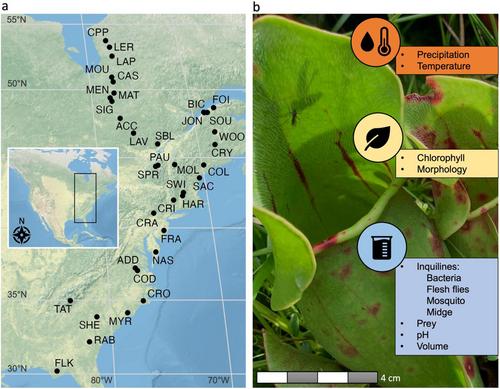Dispersal Limitation Governs Bacterial Community Assembly in the Northern Pitcher Plant (Sarracenia purpurea) at the Continental Scale
Abstract
Aim
Ecological theory suggests that dispersal limitation and selection by climatic factors influence bacterial community assembly at a continental scale, yet the conditions governing the relative importance of each process remains unclear. The carnivorous pitcher plant Sarracenia purpurea provides a model aquatic microecosystem to assess bacterial communities across the host plant's north–south range in North America. This study determined the relative influences of dispersal limitation and environmental selection on the assembly of bacterial communities inhabiting S. purpurea pitchers at the continental scale.
Location
Eastern United States and Canada.
Time Period
2016.
Major Taxa Studied
Bacteria inhabiting S. purpurea pitchers.
Methods
Pitcher morphology, fluid, inquilines and prey were measured, and pitcher fluid underwent DNA sequencing for bacterial community analysis. Null modelling of β-diversity provided estimates for the contributions of selection and dispersal limitation to community assembly, complemented by an examination of spatial clustering of individuals. Phylogenetic and ecological associations of co-occurrence network module bacteria was determined by assessing the phylogenetic diversity and habitat preferences of member taxa.
Results
Dispersal limitation was evident from between-site variation and spatial aggregation of individual bacterial taxa in the S. purpurea pitcher system. Selection pressure was weak across the geographic range, yet network module analysis indicated environmental selection within subgroups. A group of aquatic bacteria held traits under selection in warmer, wetter climates, and midge abundance was associated with selection for traits held by a group of saprotrophs. Processes that increased pitcher fluid volume weakened selection in one module, possibly by supporting greater bacterial dispersal.
Conclusion
Dispersal limitation governed bacterial community assembly in S. purpurea pitchers at a continental scale (74% of between-site comparisons) and was significantly greater than selection across the range. Network modules showed evidence for selection, demonstrating that multiple processes acted concurrently in bacterial community assembly at the continental scale.


 求助内容:
求助内容: 应助结果提醒方式:
应助结果提醒方式:


